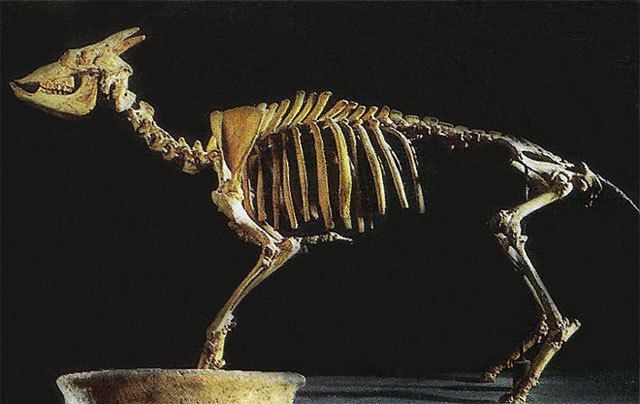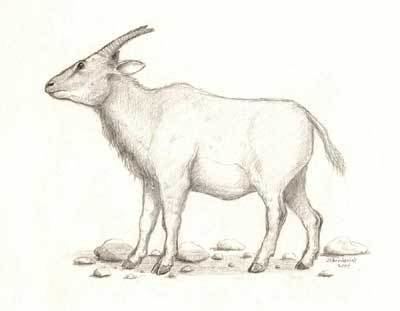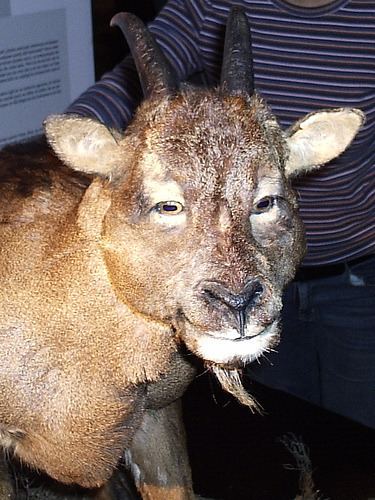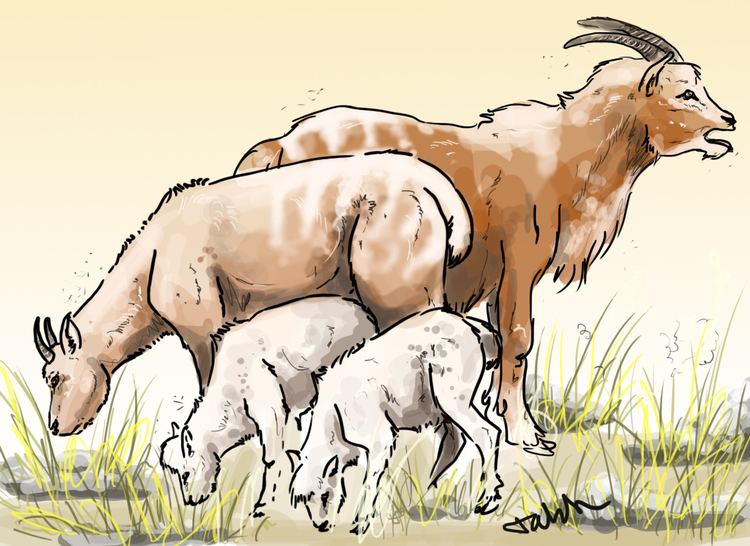Genus †Myotragus Phylum Chordata Order Even-toed ungulate | Scientific name Myotragus balearicus Rank Species | |
 | ||
Similar | ||
Myotragus balearicus espeleobusseig
Myotragus balearicus (Greek-derived Neo-Latin: μῦς and τράγος and Βαλεαρίδες "Balearian mouse-goat"), also known as the Balearic Islands cave goat, a species of the subfamily Caprinae which lived on the islands of Majorca and Minorca until its extinction around 5,000 years ago. This animal was previously described as an 'odd goat,' but since the genetic analyses done at the University of Pompeu Fabra of Barcelona, it seems that Myotragus was more closely related to sheep than to goats.
Contents
- Myotragus balearicus espeleobusseig
- Myotragus balearicus 1 v rtebras sacras
- Description
- Feeding
- Reproduction
- Domestication
- Origins
- Extinction
- Discovery
- References

Myotragus balearicus 1 v rtebras sacras
Description

Its eyes were not directed towards the sides, as are those of nearly all the herbivorous mammals, but towards the front, granting them stereoscopic vision. The lower jaw contained two perennial-growth incisors, like rodents and lagomorphs, but not other ungulates. The lower jaw usually lacked other incisors, though some jaws have been found with vestigial second incisors. The upper jaw lacked incisors. The rest of its teeth were molars and premolars adapted to the crushing of vegetal matter. The nose was short in comparison with the rest of the skull, similar to the noses of rabbits and hares. Finally, both sexes had at the top of the head two very short horns. It is possible these horns were longer, having short bone-bases and long horn-covers, but no complete horns have been found.

Myotragus balearicus was quite small in size (standing about 50 centimetres high at the shoulder) and weighed between 50 and 70 kilograms. The legs were proportionately shorter than those of other related and less flexible bovids, which did not make Myotragus balearicus exceptionally fast. This was not a serious problem because on the islands there were no predators except for some birds of prey, from which they probably hid in the vegetation. On the shoulders they had a pronounced hump, while the back was bent in the hindquarters. The legs, like many from the order Artiodactyla, had four fingers of which only two were used to walk. The tail was rather long in comparison to the rest of the body.

The bone histology of Myotragus shows lamellar-zonal tissue throughout the cortex, a feature otherwise typical of ectothermic reptiles. The growth of bones in Myotragus is unlike any other mammal and similar to crocodilians in showing slow and adaptive rates, intermittently ceasing growth altogether, and reaching somatic maturity by about 12 years. This pattern of growth indicates that Myotragus, in the same way as extant reptiles, adapted its metabolism to changing food and water availability, and ambient temperatures.
Feeding

The fossil remains of Myotragus balearicus seem to indicate that this animal was a browser, like the present goats. It fed on all kinds of shrub vegetation and low branches of the trees of the Mediterranean climate, although it had a special predilection to endemic Balearic shrubs. The fossil record of Majorca and Minorca, as well as the absence of grazing animals, seem to indicate that the primitive Balearic Islands were covered by forests before human colonisation and that herbaceous grassland of appreciable size did not exist. In this habitat, Myotragus would move about in solitude or in small groups.
Reproduction

Not much is known about the reproductive habits of this species. In 1999 the skeleton of a newly born individual was found near Manacor in the northeast of Majorca. It was found that a Myotragus newborn was quite large in proportion to the size of the mother, and probably it could walk and follow its progenitor around soon after being born. It seems that it did not take a long time maturing, perhaps only a year or two.
The fact that the species conserved the horns is a possible indication that the males used them to fight for their right to reproduce, but the lack of sexual dimorphism invites one to think this species was not polygamous or, at least, the males did not build "harems." Given the ostensibly short length of its horns, in combat Myotragus had to punch more towards the flanks (as do many small antelope) than to fight head to head (more typical of larger ungulates).
The Mediterranean climate is seasonal; thus, it is thought that Myotragus had an annual mating season, but it is not known in what part of the year this occurred. It is thought that the seasonal differences, especially in rainfall, were somewhat less pronounced during the animal's existence than they are today, and that the period of gestation cannot be deduced with certainty.
Domestication
In 1969 it was suggested that Myotragus shows signs of domestication but this is now disputed.
Origins
The unique characteristics of Myotragus balearicus are a consequence of a prolonged process of evolution on the islands (a clear example of island dwarfing). In this type of isolation, the ungulates tend to become smaller while rodents and lagomorphs increase their size, as happened to the Hypnomys, the giant dormouse that shared a habitat with Myotragus. Such species also tend to lose their fear reaction towards predators if none occur on the islands. A clear example of this is the loss of the capacity to run at high speed, the development of stereoscopic vision (which is useful to calculate distances, but not so to watch for predators) and the proportional reduction of the brain. This has also been observed in the Homo floresiensis, a newly discovered dwarf-like human species on the island of Flores, Indonesia.
The analyses of DNA and the oldest fossils (Pliocene 5.7 million years ago) of the island of Majorca (Myotragus pepgonellae) indicate that Myotragus balearicus, in spite of being a browsing animal, descended originally from grazers. The closest related species to Myotragus are ovine, such as the extinct Nesogoral of the Plio-Pleistocene of Sardinia, the old Gallogoral of France (possible mainland ancestor of both Myotragus and Nesogoral), Ovis (present sheep and mouflon) and the mountain goats of Central Asia. The last ancestor common to Myotragus and Nesogoral arrived at Majorca and Sardinia around 6 million years ago, a time at which the Straits of Gibraltar were closed and the Mediterranean Sea was a small collection of salty lakes. Later on, the opening of the straits and the massive salt water inflow isolated the animal populations, which diversified in the new Mediterranean islands created by tectonic forces. At the same time, climatic change replaced the vegetation of subtropical type with the present one of Mediterranean type, forcing Myotragus to develop drastic changes in its feeding and set of teeth.
Strangely, Myotragus initially only colonized the island of Majorca. On Ibiza a strange ecosystem without terrestrial mammals developed in which birds and bats were the main vertebrates, while in Minorca a giant rabbit evolved that covered the same niche as Myotragus in Majorca. With the level of the sea falling in the glacial era, Majorca and Minorca were united and Myotragus replaced the great Minorcan lagomorphs. Both islands separated again at the beginning of the Holocene.
Extinction
Diverse datings indicate that the three native terrestrial mammals of Majorca (Myotragus, Hypnomys and the giant shrew Nesiosites) disappeared all in the same very short period of time, during the third millennium BC.
During years of continued discussion between scientists, some said the extinction was caused by climate change, while others maintained they were exterminated by the first human settlers of the Balearic Islands. Various evidence could support both opinions; as a result, this question is still not answered unequivocally.
The dominant theory is the one that postulates an extinction by human causes. Traditional methods had dated the first human colonization of the Balearic Islands towards 5000 BC or even before, but subsequent tests with modern methods of dating clearly indicate that there was no human presence before 3000 BC. This date agrees very closely with the fast decline of the three forms.
The first Balearic settlers had a Neolithic culture, although they continued living in caves, which are plentiful on the islands. In these have been found numerous animal bones, especially those of Myotragus, with evidence of carving and denting by humans. Most surprising is that not all Myotragus arrived dead at the caves, but seem to have been kept alive for some time there. Many had their horns trimmed, which healed later. This may mean that their captors were attempting to domesticate them. Domestication ultimately did not succeed, probably because Myotragus would not reproduce in captivity or not at a suitable speed, as only remains of adult individuals have been found.
Human hunting, the failure of domestication, the introduction of domestic animals like goats (that competed with Myotragus for the same food), cows, pigs and sheep (and consequently, the destruction of the forests to create places for them to pasture) and dogs (which could have preyed on Myotragus) were the probable causes for the extinction of this animal.
Discovery
Myotragus balearicus was first excavated and identified in Majorca in 1909 by the archaeozoologist Dorothea Bate.
